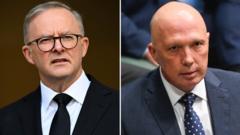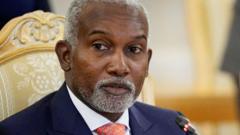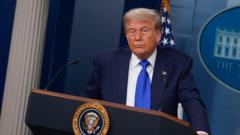As Prime Minister Anthony Albanese officially announced the election date after meeting with the Governor General, the nation anticipates a tightly contested race primarily between Albanese's Labor Party and the opposition led by Peter Dutton of the Liberal-National coalition. Polls indicate a narrow margin reflecting a potential for an alliance with independent and minor party members, reminiscent of the 2022 elections that saw significant gains for smaller parties.
Australia's Federal Election Scheduled for May 3 Amid Climate and Economy Concerns

Australia's Federal Election Scheduled for May 3 Amid Climate and Economy Concerns
Australia is set to hold its federal election on May 3, 2024, with pressing issues like climate action and the economy at the forefront of voter concerns.
With rising costs of living, affordability in housing and groceries, access to healthcare, and community safety taking center stage, Albanese's government is working to reinforce its position amidst growing scrutiny. The Prime Minister has committed to enhancing free healthcare access and proposing modest tax cuts. Conversely, Dutton promises a restoration of stability, focusing on crime reduction and economic improvement as key priorities.
The upcoming election marks a critical moment for both major parties, each needing 76 seats in the 150-member House of Representatives to secure a governing majority. The last decade of political turbulence in Australia—characterized by six leadership changes in eight years—has created a crucial environment for voters seeking stability and effective action on climate issues.
During his tenure after the 2022 election, Albanese has embraced climate reform, including a legally mandated emissions reduction strategy, though debates persist on the government’s ambition and effectiveness in combating climate change. Dutton comes to the fore from a background in law enforcement and significant ministerial roles, contrasting Albanese with a more conservative approach and individualistic stance on social issues.
The 2024 election not only tests the resolve of the current administration but also the electorate's appetite for continued climate action amidst economic challenges and social discourse. The outcome could be pivotal in shaping Australia's environmental future.
As the election date approaches, party strategies and voter sentiments will undoubtedly evolve, laying the groundwork for a possible shift in governance, especially amid concerns surrounding global economic pressures and their impact on Australia.
The upcoming election marks a critical moment for both major parties, each needing 76 seats in the 150-member House of Representatives to secure a governing majority. The last decade of political turbulence in Australia—characterized by six leadership changes in eight years—has created a crucial environment for voters seeking stability and effective action on climate issues.
During his tenure after the 2022 election, Albanese has embraced climate reform, including a legally mandated emissions reduction strategy, though debates persist on the government’s ambition and effectiveness in combating climate change. Dutton comes to the fore from a background in law enforcement and significant ministerial roles, contrasting Albanese with a more conservative approach and individualistic stance on social issues.
The 2024 election not only tests the resolve of the current administration but also the electorate's appetite for continued climate action amidst economic challenges and social discourse. The outcome could be pivotal in shaping Australia's environmental future.
As the election date approaches, party strategies and voter sentiments will undoubtedly evolve, laying the groundwork for a possible shift in governance, especially amid concerns surrounding global economic pressures and their impact on Australia.

















